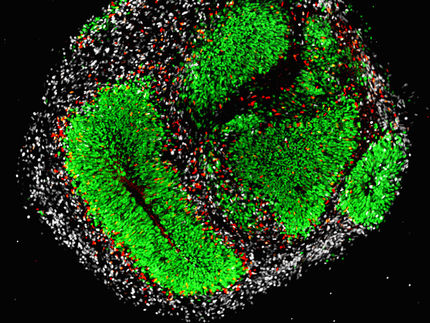Keeping stem cells from changing fates
Johns Hopkins researchers have determined why certain stem cells are able to stay stem cells. The report in Cell Stem Cell reveals that an enzyme that changes the way DNA is packaged in cells allows specific genes to be turned on and off, thereby preventing a stem cell from becoming another cell type.
Each cell has to fit in 6 feet of highly organized and carefully packaged DNA. Some regions of the DNA are more tightly compacted than others and this structure is dynamic. There are specific enzymes that change how condensed the DNA is to help turn genes on and off. The genes that are turned off generally are found in tightly condensed DNA. To turn genes on, the DNA around those genes is loosened so that activators and other proteins can interact with the DNA.
The Johns Hopkins researchers believed that restructuring the DNA by proteins that make up chromosomes could play a role in deciding if a stem cell was going to change into another cell or stay a stem cell, since change in the DNA packaging would allow for many genes to be turned off and other genes to be turned on.
By genetically engineering flies to lack several proteins involved in packaging DNA, in the stem cells of the testes in fruit flies, the research team found that if the enzyme NURF is removed from testis stem cells, the stem cells disappeared. A constant supply of stem cells in the testes is responsible for making cells that eventually become sperm. More staining of the testes with colored markers showed that these cells hadn't gone away completely, but were becoming another cell type, sperm cells.
"This experiment was really hard to do," says Erika Matunis, Ph.D., professor of cell biology from the Johns Hopkins School of Medicine. "As soon as you remove NURF from these cells, they leave, so you have to take a lot of samples to see how the cells are moving, since we are not looking at living moving cells but rather individual flashes in time."
So how does NURF keep stem cells as stem cells? NURF can both turn on and turn off genes. "We still don't know what is happening in this case with how NURF regulates genes to keep stem cells from changing," says Matunis.
Matunis' group last year discovered proteins that were able to prevent stem cells from becoming other types of cells in the fruit fly testes. Now they showed that these same proteins also work with NURF to keep stem cells from changing. "By any means this isn't the only pathway though, it's just the one we know more about" says Matunis. "It's probably a tangled hair ball of all kinds of signals going on in these cells that prevent these stem cells from differentiating."
NURF keeps stem cells from changing in fruit fly testes, but whether NURF keeps other stem cells from changing still needs to be tested. Matunis believes that proteins similar to NURF will factor into whether a cell decides to change or not in other cell types.
Other news from the department science

Get the life science industry in your inbox
By submitting this form you agree that LUMITOS AG will send you the newsletter(s) selected above by email. Your data will not be passed on to third parties. Your data will be stored and processed in accordance with our data protection regulations. LUMITOS may contact you by email for the purpose of advertising or market and opinion surveys. You can revoke your consent at any time without giving reasons to LUMITOS AG, Ernst-Augustin-Str. 2, 12489 Berlin, Germany or by e-mail at revoke@lumitos.com with effect for the future. In addition, each email contains a link to unsubscribe from the corresponding newsletter.























































